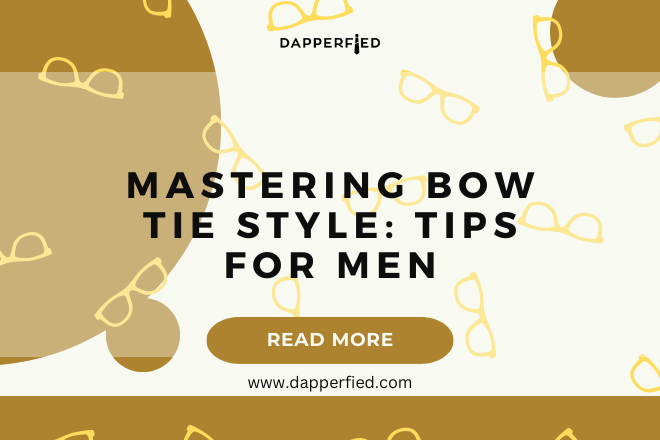
Men's Style
Master the Art of Tying a Tie: A Guide for Men
Ties have been a staple of men’s fashion for centuries, with their origins dating back to the 17th century during the Thirty Years’ War in France. Croatian mercenaries, serving in the French army, wore small, knotted neckerchiefs as part of their uniform. These caught the attention of the Parisians, who dubbed them “cravates,” after the Croatians. This fashion trend quickly spread throughout Europe and eventually made its way to England, where it became known as the “tie.” Ties have since evolved from simple pieces of cloth to intricate and stylish accessories that can make a statement and complete a look.
Ties have been a symbol of status, power, and style throughout history. In the 1920s, ties became wider and more colorful, reflecting the flamboyant style of the era. During the 1940s and 1950s, ties became narrower and more conservative, reflecting the post-war austerity. In the 1960s, ties became even narrower and more colorful again, reflecting the bold and vibrant fashion of the time. Today, ties come in a wide variety of styles, colors, and patterns, allowing men to express their personal style and make a statement with their choice of tie.
Key Takeaways
- Ties have a long history, dating back to the 17th century, and have evolved in style and significance over time.
- When choosing a tie for an occasion, consider the formality of the event and the color and pattern of your outfit.
- The classic four-in-hand knot is a versatile and easy-to-tie option for most occasions.
- The half Windsor and full Windsor knots are larger and more formal options that can add a touch of elegance to your look.
- Properly adjusting and styling your tie includes ensuring the length is appropriate and the knot is centered and symmetrical.
Choosing the Right Tie for the Occasion
Choosing the right tie for the occasion is essential for creating a polished and put-together look. When selecting a tie, consider the formality of the event and the color and pattern of your outfit. For formal events such as weddings or business meetings, opt for a silk tie in a solid color or subtle pattern. For more casual events, such as a night out with friends or a weekend brunch, you can experiment with bolder colors and patterns, such as stripes or polka dots.
It’s also important to consider the color of your outfit when choosing a tie. A general rule of thumb is to select a tie that is darker than your shirt. For example, if you’re wearing a light blue shirt, opt for a navy or dark red tie. If you’re wearing a dark suit, such as charcoal or navy, you can choose a tie that provides a pop of color, such as a bright red or yellow. Additionally, consider the season when choosing a tie. In the spring and summer, lighter colors and pastel tones are more appropriate, while in the fall and winter, deeper and richer colors are more fitting.
Step-by-Step Instructions for Tying a Classic Four-in-Hand Knot
The classic four-in-hand knot is one of the most popular and versatile ways to tie a tie. It’s simple to master and works well with most types of ties and collar styles. To tie a four-in-hand knot, start by draping the tie around your neck with the wide end on your right side and the narrow end on your left side. Cross the wide end over the narrow end, then bring it under and over the narrow end to form a loop. Pull the wide end through the loop and tighten the knot by holding the narrow end and sliding the knot up to your collar.
Another way to tie a four-in-hand knot is to start with the wide end on your left side and the narrow end on your right side. Cross the wide end over the narrow end, then bring it under and over the narrow end to form a loop. Pull the wide end through the loop and tighten the knot by holding the narrow end and sliding the knot up to your collar. Once you’ve mastered this classic knot, you can experiment with different variations, such as adjusting the length and width of the knot to suit your personal style.
Exploring Alternative Tie Knots: The Half Windsor and Full Windsor
| Tie Knot | Difficulty Level | Symmetry | Size |
|---|---|---|---|
| Half Windsor | Medium | Symmetrical | Medium |
| Full Windsor | Hard | Symmetrical | Large |
While the four-in-hand knot is a classic go-to for many men, there are alternative tie knots that can add variety and sophistication to your look. The half Windsor knot is a slightly larger and more symmetrical knot than the four-in-hand. To tie a half Windsor knot, start by draping the tie around your neck with the wide end on your right side and the narrow end on your left side. Cross the wide end over the narrow end, then bring it under and over the narrow end to form a loop. Next, bring the wide end over the loop from right to left, then bring it under and over the narrow end to form another loop. Finally, pull the wide end through the second loop and tighten the knot by holding the narrow end and sliding the knot up to your collar.
The full Windsor knot is even larger and more symmetrical than the half Windsor knot, making it ideal for formal events or when wearing a spread collar shirt. To tie a full Windsor knot, start by draping the tie around your neck with the wide end on your right side and the narrow end on your left side. Cross the wide end over the narrow end, then bring it under and over the narrow end to form a loop. Next, bring the wide end over the loop from right to left, then bring it under and over the narrow end to form another loop. Then, bring the wide end over the loop from left to right, then bring it up through the loop and down through the second loop. Finally, tighten the knot by holding the narrow end and sliding the knot up to your collar.
Tips for Properly Adjusting and Styling Your Tie
Once you’ve tied your tie, it’s important to properly adjust and style it to achieve a polished look. Start by ensuring that your tie is centered between your collar points and that it reaches just above your belt buckle. Adjust the length of your tie by holding onto both ends of the tie and sliding it up or down until it’s at the desired length. If you’re wearing a slim tie, you can opt for a shorter length, while wider ties may require a longer length.
To achieve a clean and polished look, make sure that your tie is flat against your shirt without any twists or wrinkles. You can use your fingers to smooth out any wrinkles or creases in your tie before securing it with a tie clip or tucking it into your shirt. Additionally, ensure that your tie is properly secured by fastening it with a tie clip or tucking it into your shirt to prevent it from moving around throughout the day.
Caring for Your Ties: Storage and Maintenance

Proper storage and maintenance are essential for preserving the quality and longevity of your ties. When not in use, hang your ties on a tie rack or hanger to prevent wrinkles and creases from forming. Avoid hanging them on sharp edges or hooks that can cause damage to the fabric. If you don’t have access to a tie rack or hanger, you can also roll up your ties and store them in a drawer to prevent them from getting wrinkled.
To maintain the shape of your ties, untie them after each wear rather than pulling them over your head. This will help prevent stretching and distortion of the fabric over time. If your ties become wrinkled or creased, you can use a handheld steamer to gently remove any wrinkles without causing damage to the fabric. Avoid using an iron on your ties as this can cause irreparable damage to delicate fabrics.
Embracing Your Personal Style: Using Ties to Make a Statement
Ties are not just an accessory; they are an opportunity to express your personal style and make a statement. Experiment with different colors, patterns, and textures to add personality to your look. For formal events, consider wearing a silk tie in a bold color or pattern to stand out from the crowd. For more casual occasions, you can opt for a knit tie or a patterned tie to add visual interest to your outfit.
In addition to experimenting with different styles of ties, consider pairing them with complementary accessories such as pocket squares or tie bars to elevate your look even further. A well-coordinated pocket square can add an extra touch of sophistication to your outfit, while a stylish tie bar can keep your tie in place while adding a touch of flair.

Ultimately, embracing your personal style with ties is about having fun and feeling confident in what you wear. Whether you prefer classic and timeless looks or bold and daring styles, there are endless possibilities for using ties to make a statement and showcase your individuality.
In conclusion, ties have come a long way from their humble beginnings as simple neckerchiefs worn by Croatian mercenaries in France. They have evolved into an essential accessory for men’s fashion that can be used to express personal style and make a statement. By choosing the right tie for each occasion, mastering different tie knots, properly adjusting and styling ties, caring for them properly, and embracing personal style with ties, men can elevate their look and exude confidence in any setting. Ties are not just an accessory; they are an opportunity for self-expression and individuality in men’s fashion.
If you’re looking to complete your dapper look, you might want to consider investing in a stylish watch. Large face watches are incredibly popular right now, and this article explains why they have become a must-have accessory for men. Pairing a large face watch with a slim suit, like the Tommy Hilfiger Men’s Nathan Blue Stripe Two-Button Trim Fit Suit, can elevate your style to the next level.
FAQs
What is the best knot for tying a tie?
The best knot for tying a tie is generally considered to be the Windsor knot, also known as the Full Windsor or Double Windsor. It is a wide, triangular knot that is suitable for most dress shirts and occasions.
How do I choose the right tie length?
The standard length for a tie is around 57 to 58 inches. Ties that are too short or too long can look awkward, so it’s important to choose a tie that reaches the middle of your belt buckle when tied.
What are the different types of tie knots?
There are several different types of tie knots, including the Windsor knot, Half Windsor knot, Four-in-Hand knot, Pratt knot, and the Bow tie knot. Each knot has its own unique look and level of formality.
How do I tie a tie step by step?
To tie a tie, start by draping the tie around your neck with the wide end hanging about 12 inches lower than the narrow end. Cross the wide end over the narrow end, then bring it up and through the loop around your neck. Cross the wide end over the narrow end again, then bring it up and through the loop around your neck. Finally, bring the wide end down through the knot in front and adjust it to your desired tightness.
What type of tie should I wear for a formal event?
For a formal event, it is best to wear a silk tie in a solid color or subtle pattern, such as a classic black, navy, or dark red tie. The tie should be paired with a well-fitted dress shirt and suit to complete the formal look.















